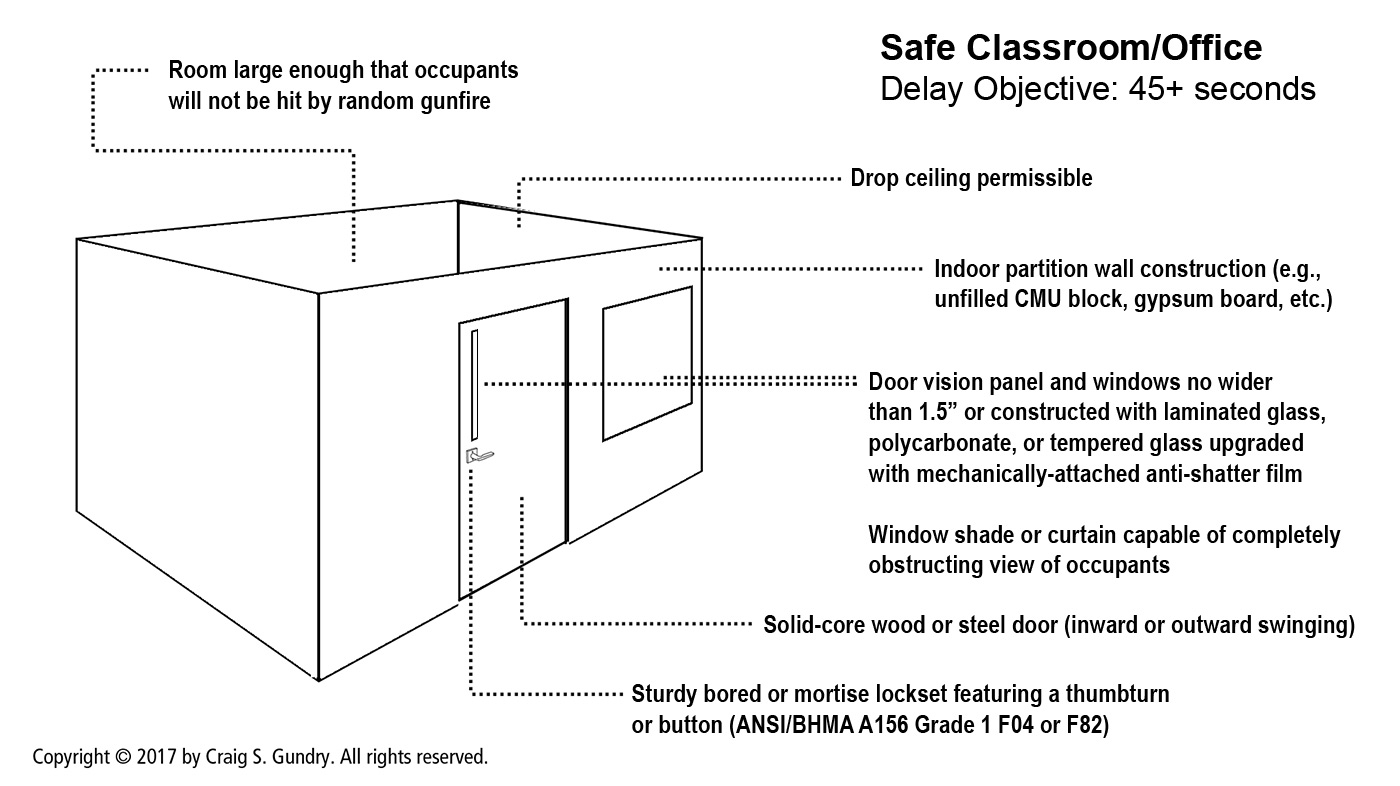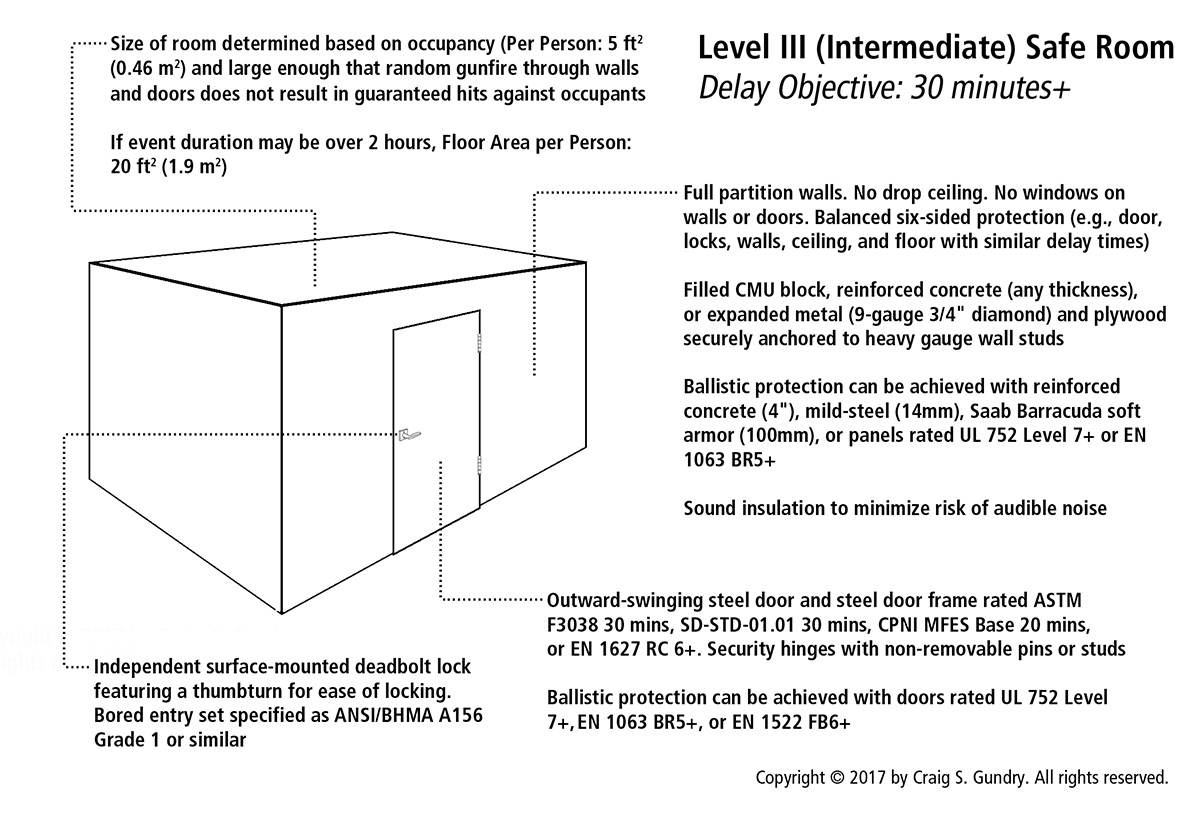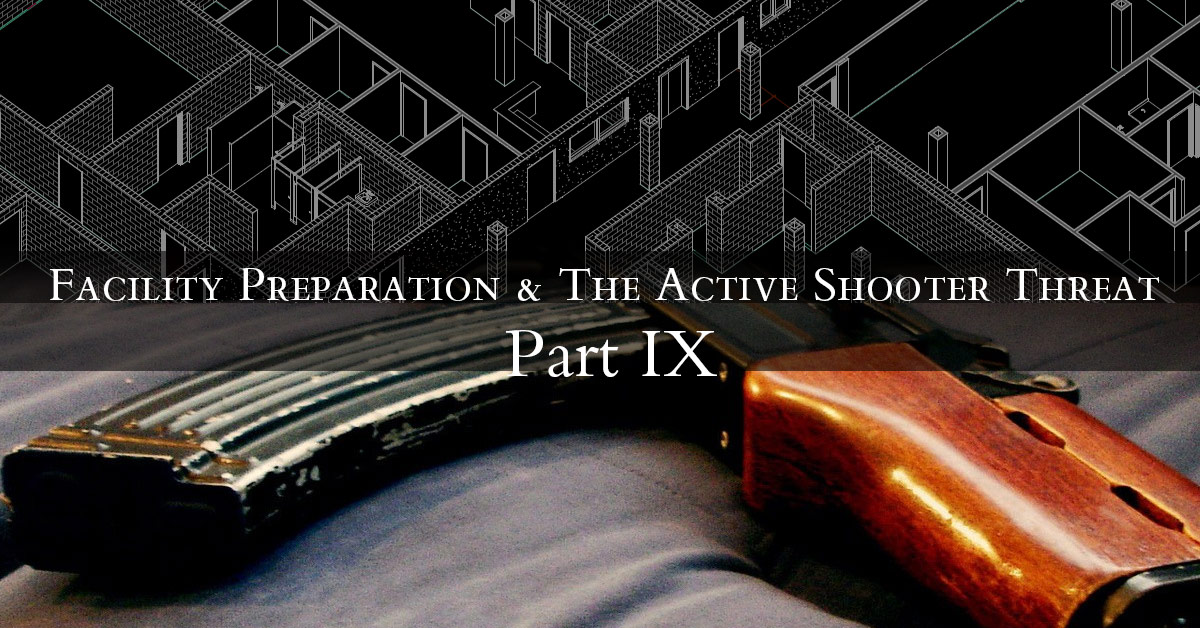
Safe Rooms, Classroom Security, & The Active Shooter
One of the most common problems we encounter in our work as security consultants is the absence of safe rooms and secure classrooms capable of providing sufficient delay during active shooter and terrorist attack events. In this article, we’ll explore ideal design criteria for safe rooms and important classroom security issues for addressing a wide spectrum of active shooter threats.
As discussed elsewhere in this series, most organizations concerned about active shooter violence have adopted the DHS ‘Run-Hide-Fight’ doctrine or related variations (i.e., “Run-Hide-Report”) as the basis for designing facility emergency action plans and training employees. This simplified guidance is presented as a prioritized list of preferred protective responses when an active shooter attack is recognized. “Run,” for instance, should always be the first option when the opportunity is present. If “Run” is not possible, then “Hide” is the next prioritized option.
Although “Run” (escape) is universally the preferred response, there are situations where “Hide” may be a necessary action due to the impracticality of rapidly evacuating people unable to take independent action for their personal safety (such as kindergarten students or nursing home residents). Additionally, there are often situations where trying to escape may be more dangerous than simply remaining in place. One good example is an attack launched at ground level in a multi-story building. In these situations, people rarely have accurate and real-time knowledge of the gunman’s location and safe routes of escape. Trying to evacuate from upper floors and through lower levels of a building is often far more dangerous than barricading in a nearby safe location.
In recent years, DHS has improved its presentation of active shooter education with more detailed guidance about circumstances that warrant different responses. Although single syllable words (“Run-Hide-Fight”) are easy for the public to remember, limited understanding can easily result in unsafe actions. “Hide,” for instance, is vague and implies no other essential protection than concealment. In our employee training programs, we use the term “Barricade,” which describes the recommended action more clearly. Simply put, hiding should never be regarded as a safe action unless the location provides adequate protection against forced entry.
To facilitate safe “Barricade” during armed attacks, facilities should ensure adequate availability of safe rooms and classrooms for people to take refuge if escape is not feasible.
In the security and emergency management communities, the term “safe room” often has varying definitions depending on purpose. In the executive protection industry, this term often implies a room engineered to provide significant delay against intrusion by a committed adversary employing advanced entry methods, ballistic protection, special life safety systems, multiple modes of communications, supplies to sustain extended refuge, etc. For organizations such as FEMA, the term broadly applies to any room or indoor shelter area designed to protect occupants from a hazard such as tornados, outdoor hazardous materials incidents, and other threats.
For the purpose of this article, a safe room (or secure classroom) is any room designated or constructed for the purposes of providing reasonable delay against forced entry considering the methods and tools likely to be employed by an active shooter.
So how much delay is necessary for a safe room to be considered “safe?”
The U.S. Department of Defense’s Unified Facilities Criteria UFC 4-023-10 answers this simply: “For the Forced Entry tactic, specify the required protection time based on the response time of the security forces determined in security forces evaluation in addition to the DBT [Design Basis Threat] and the LOP [Level of Protection].”
Simply stated, a safe room should delay an adversary from forced entry into the room long enough to allow the response force to intervene and neutralize the adversary. The necessary delay time being determined by the response force time and the methods and tools likely to be used by the attacker in penetrating the room.
From a textbook perspective, this is the correct answer and the ideal objective of performance-based physical security design. Although there are situations where this type of textbook approach is justified, in many workplace situations, designing safe rooms according to ideal performance-based goals is impractical and unnecessary when considering the historical behavior of attackers during active shooter events.
In a previous article, we explored the topic of adversary effort and commitment to attack people located inside locked rooms. In most attacks, adversaries focus on targets of easiest opportunity while moving through the building using visually-obvious routes and unlocked/unobstructed portals (e.g., doors, windows, etc.). In most previous attacks where adversaries committed effort to forcibly enter secured rooms, intervention by police or security forces was delayed and attackers had exhausted all available targets. The majority of these situations occurred in locations where terrorists employed assault teams or security forces were unprepared for immediate tactical response (e.g., Libya, Afghanistan, India, Kenya, etc.). And in these types of environments, DoD’s performance-based approach is often justified.
In Western countries where the majority of attacks are committed by a single active shooter and police intervention is typically under 20 minutes, a delay time of 45 seconds or more is often effective at frustrating forced entry and achievable without significant expense.
In these situations, I recommend designating or upgrading an abundant number of rooms throughout the facility to function as safe refuge rooms. This is especially critical in facilities where it is expected that vulnerable populations will refuge during an attack such as schools, nursing homes, and hotels. In these cases, all classrooms, guest rooms, and any other rooms where people are expectedly located should be capable of delaying forced entry by 45 seconds or more. In office-type situations, we recommend that there are at least several rooms on each floor and wing of the building that meet this basic criterion. This can include conference rooms, restrooms, break rooms, storage rooms, and offices which are reliably accessible to employees.
Basic Safe Room and Classroom Security Criteria for Active Shooter Protection
As a minimum, all rooms designated for safe refuge should feature intrusion-resistant doors and mechanical locks with a button or thumb turn.
As a general rule, outward-swinging doors provide the best protection against exterior ramming force due to resistance of the rebate within the frame. Additionally, adversaries attempting to pull open locked outward-swinging doors without the aid of tools are at a mechanical disadvantage. If rooms earmarked as potential safe rooms feature existing inward-swinging doors, door hardware (e.g., locks, strikes, and frames) should be carefully specified to ensure adequate resistance against ramming force.
Most doors certified under forced entry standards are constructed of steel. However, indoor rooms potentially earmarked for use as safe rooms in offices and schools are often equipped with solid core wood or solid wooden doors. Solid core doors are constructed with a composite wood core and overlaid with hardwood veneer for aesthetic appearance. The times required to penetrate solid core and solid wooden doors using methods likely to be used during active shooter attacks has never been published. Nevertheless, for protection against a gunman employing impact force without additional tools, solid door leafs (regardless of construction) are unlikely to be the point of failure when compared to the potential vulnerability of locks, strikes, wooden frames, and vision panels.
For protection against entry by buttstock impact and kicking, all lever and knob sets on safe room doors should ideally be rated ANSI/BHMA A156 Grade 1 or have a minimum Security Grade of 4 under Europe’s EN 12209. Mechanical locks rated ANSI/BHMA Grade 1 and EN 12209 Security Grade 4+ have been successfully evaluated under a variety of static force and torque tests.
All mechanical locks on safe room doors should be classified as “office-function” locks (ANSI mortise F04 or bored F82) featuring buttons or thumb turns for ease of locking under stress. In several previous active shooter attacks, critical doors on rooms where people were seeking refuge remained unlocked during the event due to the absence of a key. And as discussed in previous articles, good preparation for active shooter events should anticipate the effects of the Sympathetic Nervous System (SNS) on employee response. During high stress events, the SNS is often activated with impairing effects on cognitive function and fine motor coordination. These negative effects of the SNS can interfere with even simple tasks such as locating and manipulating keys.
Ironically, considering the history of active shooter attacks in American schools, locks classified by ANSI as “classroom function” (mortise F05 and bored F84) are perhaps the worst choice for safe room applications and should be avoided when possible. Classroom function locks are only lockable by a key from the outer side of the door. Not only do these locks require a key, but they also require the occupant to open the door and reach into the hallway to secure the lock.
Door vision panels and indoor windows on safe rooms should ideally be 96 in2 (619 cm2) or smaller in accordance with U.S. DoD guidelines. We also recommend that any unprotected glass windows or vision panels within arm’s reach (approx. 36″ or 91.5 cm) of door handles and locks have a width of no more than 1.5″ (3.8 cm). If window dimensions do not conform to the aforementioned guidelines, glass should be replaced with intrusion-resistant materials such as laminated glass, polycarbonate, or upgraded with properly-attached anti-shatter film.
All windows and door vision panels should also feature blinds, shades, or curtains to conceal occupants while refuging in place.
In low-risk situations where the primary design objective is to simply frustrate adversary access, partition walls and drop ceilings are low priority concerns compared to doors and glazing. As described earlier in this article, armed attackers most often use visually-obvious portals (e.g., doors and windows) as their main pathways for movement. Although entry through drop ceilings is certainly possible, our research has not revealed any active shooter attacks to date where drop ceilings or vulnerable gypsum-board walls were exploited as a means of accessing people located in locked rooms.
Following is a summary of our criteria for a basic-level safe room/classroom applicable in most workplace and school situations.

In locations where the majority of attacks are committed by a single attacker and armed security or police response is typically under 20 minutes, a delay time of 45 seconds or more is often effective at frustrating forced entry. Rarely in these situations do we find adversaries committing time and effort to enter locked rooms unless encouraged by the presence of obvious vulnerabilities.
In many facilities, establishing a versatile availability of rooms that meet this 45 second delay objective is easily achievable. In many facilities I work with as a consultant, there are often vulnerabilities that need to be addressed resulting from original design (such as tempered glass windows or poor locks), but rarely does the situation require major expense.
However, situations occasionally arise which require a creative solution or more robust protective measures. Let’s explore some approaches to these challenges…
Facilities and Schools With Minimal Safe Room/Classroom Options for Active Shooter Protection
One challenge that arises frequently is facilities designed with large open workspaces with few existing rooms sufficient for designation or upgrade as safe rooms. Some common examples include call centers, warehouses, industrial plants, entertainment facilities, and event centers. I also encounter this situation frequently with recently constructed office buildings in Europe (and a few in the US) where planners and architects have designed buildings with open floorplans to engender team collaboration or non-hierarchical workplace culture.
We also find a related problem in buildings where architects have made extensive use of tempered glass glazing in indoor wall construction. In these situations, there are often plenty of rooms present, but the cost of upgrading or replacing glazing throughout the building would be astronomical.
In any of these cases, begin by first upgrading whatever rooms are available even if it’s only a few. I encountered this situation when working with a landmark building a few years ago—120,000m2 of floor space with interior walls exclusively constructed of glass. The only rooms which had solid walls on most floors were restrooms and break rooms. So we started by making sure those rooms met essential criteria for use as safe refuge rooms while additional improvements were budgeted in a phased manner.
Another step may be constructing a limited number of rooms for use as safe refuge rooms while serving another role in day-to-day operations. One example was a government office building with open office workspaces on each floor. In this case, the solution was to construct a new conference room in a central area on each floor according to our safe refuge room specifications.
In situations where we need to rely on a limited number of safe rooms, it is crucial that the rooms we designate or upgrade are accessible to most employees when an attack occurs. For instance, a storeroom or manager’s office that is only accessible with a key possessed by a limited number of employees should not be considered as reliably available for this purpose.
If the facility has an access control system, one method of approaching this problem is to install badge readers and electromagnetic locks on these doors in addition to an “office-function” lock or single-cylinder deadbolt. During normal operations, the door remains secured using the mag lock and the mechanical lock remains unlocked. The system is then programmed so authorized employees can access the room using their access badge. However, when an armed attack event occurs, a lockdown macro programmed in the access control system is programmed to unlock this door now making it accessible to all employees. Employees refuging inside the room can then use the mechanical lock to secure the door.
As an example of this application, I had a situation with a large private school where there were very few options for safe refuge rooms in a shared arts center and athletic building. But there was a theater classroom (“black box theater”) with sufficient occupancy space for a large number of students. However, the theater room was normally secured using a mechanical lock operated by a key only possessed by theater teachers and facilities staff. To remedy this situation, the mechanical lock was kept unlocked and a mag lock was installed on the door operated by faculty badges. The access control system was subsequently programmed to unlock this door through a lockdown macro during attack events, thus making this room available to all students who can then secure the door manually using the mechanical lock.
If concerns about occupancy volume or ease of accessibility still remain after upgrading existing rooms and/or building new ones, egress design and ease of escape become top priorities (as explored in earlier articles of this series).
Advanced Safe Rooms for Active Shooter Applications
As discussed in an earlier article in this series, most active shooter attacks in Western nations are resolved by police (or suicide) in less than 20 minutes. Rare events (such as the 2016 Pulse Nightclub and 2015 Bataclan Theater attacks) had event durations as long as two hours. In these situations, a basic level safe room with a delay time of 45 seconds or more is often effective at frustrating forced entry by a gunman and achievable without great expense. However, in regions such as Africa and Southwest Asia, attacks frequently result in hostage-barricade situations due to the reluctance of police/security forces or remote location of attacked facilities (e.g., 2013 In Amenas Gas Refinery). In these types of situations, it should be expected that adversaries will have greater time, tools, and commitment to forcibly enter safe havens and secured refuge rooms.
To reliably achieve the types of delay times warranted during siege events and high-risk situations, safe rooms should be designed to provide six-sided protection (ceiling, floor, and walls) using barrier materials with similar delay time values. Wall barriers should also extend from floor-to-solid ceiling including any drop ceiling space.
Intrusion-resistant walls can be constructed using materials such as reinforced concrete, filled masonry block, expanded metal mesh, and polycarbonate-composite wall panels.
Reinforced concrete walls provide the best delay time performance against adversaries using limited toolsets. According to tests documented by Sandia, 4-inches of reinforced concrete with No. 5 rebar on 6-inch centers will provide approximately 4.7 minutes of delay against penetration with hand tools (including saw). If our threat definition is an adversary relying solely on firearm penetration and blunt object impact, reinforced concrete of any dimensions will provide almost indefinite delay.
Contrary to what many assume, unfilled concrete masonry unit (CMU) block walls provide minimal delay against forced entry and only slightly better performance than drywall against some methods of penetration. According to data published in the Barrier Technology Handbook, the mean delay time for penetrating an unfilled CMU block wall is only 36 seconds by the use of a sledgehammer. Unfilled CMU block walls are also susceptible to damage by rifle projectiles and may crumble when struck repeatedly by gunfire. For better performance in delaying forced entry, CMU block walls should be fully grouted and reinforced with rebar. According to tests documented by Sandia, filled 8-inch CMU walls with No. 5 rebar on 14-inch centers provide approximately 1.4 minutes of delay against penetration with hand tools.
Supplementing exterior drywall layers with a securely attached inner layer of expanded metal mesh is a common method of retrofitting existing walls for improved resistance against forced entry. Expanded steel constructed of 9-gauge 3/4-inch diamond mesh is a common material specification for this purpose. In this type of wall design, the expanded metal mesh is installed on the inside of the protected room and secured to wall studs by using deep screws and fasteners specially designed for this purpose. The expanded metal barrier layer is then overlaid with gypsum board or plywood. According to Sandia, a wall constructed of two layers of 3/4-inch plywood, two layers of gypsum board, and an expanded metal mesh interlayer can provide as much as 6.5 minutes of delay against penetration with hand tools.
Despite the popularity of 9-gauge material as a safe room design specification, money can often be saved by using a lighter mesh without compromising performance. If the threat definition is an adversary equipped solely with a firearm, static and dynamic impact force will be the main mechanisms of penetration, and overall strength of the fastening system will be more important than thickness of the metal fabric.
If ballistic protection is desired, walls constructed of 4-inches reinforced concrete, 8-inch filled CMU block (grouted full), and 8-inches of brick have been successfully tested by U.S. DoD to resist penetration by 7.62x51mm ammunition. Another option is constructing walls using fiberglass wall panels rated under bullet resistance standards such as UL 752, ASTM F1233-08, and EN 1063. Minimum specifications for protection against military small arms (5.56mm) would be UL 752 Level 7, F1233 R1, or EN 1063 BR5. More conservative specifications encompassing 7.62x51mm would be UL 752 Level 8, F1233 R3, and EN 1063 BR6.
If the risk level and design approach warrants door systems rated for tested delay times, doors certified under SD-STD-01.01, ASTM F3038-14, CPNI MFES, LPS 1175 have been tested against a variety of forced entry methods and often exceed requirements for protection during armed attacks. If the threat definition identifies an adversary solely employing firearms and expedient tools, any door certified under SD-STD-01.01, ASTM F3038-14, CPNI MFES, or LPS 1175 will likely far exceed performance as suggested by its certified delay time rating.
If our design objective requires ballistic protection, doors rated UL 752 level 7+ or EN 1522 FB5+ should be specified. Additionally, all doors rated under SD-STD-01.01 have been tested against penetration by 5.56mm, 7.62x51mm, and 12-gauge shotgun.
As discussed in the first part of this article, all lever and knob sets on safe room doors should ideally be rated ANSI/BHMA A156 Grade 1 or have a minimum Security Grade of 4 under EN 12209. If the design objective is to delay penetration by a committed adversary or the threat definition includes a diverse range of entry tools, locksets should also be augmented by the installation of an independent deadbolt lock. In situations where greater delay times are required or adversaries are expected to employ improved toolsets for entry, multi-point deadbolt systems provide the best protection.
Although forced entry by ballistic attack against locks and hinges has been rare during active shooter events, a number of incidents have occurred where adversaries forcibly entered/or attempted to penetrate rooms by destroying door locks with gunfire. Specifying doors certified under SD-STD-01.01, UL 752 level 7+, or EN 1522 FB5+ will address this concern. Another approach is installing a surface-mounted deadbolt lock on the inside of a solid wooden or steel door. Although most solid wooden and steel pedestrian doors are vulnerable to penetration by small arms, the door material will provide some reduction in bullet velocity and conceal the location of the lock to reduce hit probability.
As a general rule, window and door glazing should be avoided in high risk situations or applications where designers seek ambitious delay goals. Although there are glazing products capable of high delay times, such systems are quite expensive by comparison to the price of wall construction and doors. If windows are unavoidable, I recommend designing all windows in accordance with U.S. DoD recommendations—96 in2 (619 cm2) or smaller and no wider than 1.5″ (3.8 cm). For bullet resistance, specifications for protection of glazing against military small arms include EN 1063 BR5-BR7, UL 752 Level 7-9, and ASTM F1233-08 R1-R4AP.
Following is an example of how these criteria may be applied in designing a safe room with a delay time objective of 30 minutes or more.

Safe Room Kits
In environments where armed attacks have frequently resulted in siege events with durations longer than 24 hours, consider providing a kit in all safe rooms with instructions for sheltering and essential supplies.
As a starting point, kits should include basic supplies for sustaining occupants throughout the expected duration of an event including a food ration of 1,500 kcal per person, per expected day of sheltering. Although the Total Daily Energy Expenditure (TDEE) of most adults is 2,000 calories or more, a short term diet of 1,500 kcal per day is sufficient to satisfy hunger without compromising an occupant’s decision-making capabilities or energy for escape if necessary. If the safe room does not have toilet and sink, consider including hand sanitizer, water, extra-large zip lock bags, and toilet paper to facilitate hygiene needs.
Numerous victims have died from gunshot wounds due to delayed medical treatment while sheltering during siege situations. To help address this concern, consider equipping each safe room kit with one or two hemostatic dressings. Hemostatic dressings are large bandages impregnated with a clotting agent designed to delay hemorrhage from trauma wounds under the expectation of delayed hospital treatment.
If safe rooms have exterior (outdoor) windows, infrared chemical lights are another supply to consider. During siege events, one of the first priorities of police and security forces is trying to determine where people are hiding inside the building. To assist this process, occupants sheltering inside safe rooms can be instructed using emergency communications systems when to break the IR chemical light and hold it against the window. Security forces outside the building equipped with night vision equipment will be able to see the IR chemical lights. Others without night vision equipment (e.g., terrorist handlers, bystanders, news media, etc.) will be unable to view which rooms are occupied. To implement this measure correctly, instructions should be provided in the kit for use of the chemical light and how the order to break the chem light will be communicated to occupants.
References
UFC 4-023-10, Safe Havens. US Department of Defense, N.p.: 2010. pp. 11.
ANSI/BHMA A156.13, Mortise Locks and Latches. Builders Hardware Manufacturers Association (BHMA), New York, NY, 2011.
EN 12209, Building hardware – locks and latches – mechanically operated locks, latches and locking plates. European Committee for Standardization, Brussels, 2016.
UFC 4-023-10, Safe Havens. US Department of Defense, N.p., 2010.
SD-STD-01.01, Revision G. Certification Standard. Forced Entry and Ballistic Resistance of Structural Systems. U.S. Department of State, Bureau of Diplomatic Security, Washington, DC, 1993.
ASTM F3038-14, Standard Test Method for Timed Evaluation of Forced-Entry-Resistant Systems, ASTM International, West Conshohocken, PA, 2014
Barrier Technology Handbook, SAND77-0777. Sandia Laboratories, 1978. pp. 4.2-6
Ibid. pp. 4.5-2
The vulnerability of unfilled concrete block walls to penetration and potential failure by gunfire is well demonstrated by numerous “backyard test” videos posted on YouTube. Most videos posted on YouTube display the vulnerability of stacked block walls without mortar. Finished walls will likely be more resistant to critical failure. Example: https://www.youtube.com/watch?v=Hxn8TS9cb3o
Barrier Technology Handbook, SAND77-0777. Sandia Laboratories, 1978. pp. 4.5-2
Ibid. pp. 4.9-1,2
UFC 4-023-07, Design To Resist Direct Fire Weapons Effects. US Department of Defense, N.p.: 2008.
UL 752, Standard for Bullet-Resisting Equipment. UL, N.p.: 2005.
ASTM F1233-08, Standard Test Method for Security Glazing Materials And Systems. ASTM International, West Conshohocken, PA, 2013
EN 1063:2000, Glass in building – Security glazing – Testing and classification of resistance against bullet attack. European Committee for Standardization, Brussels, 2000.
UFC 4-023-10, Safe Havens. US Department of Defense, N.p., 2010. pp. 42

